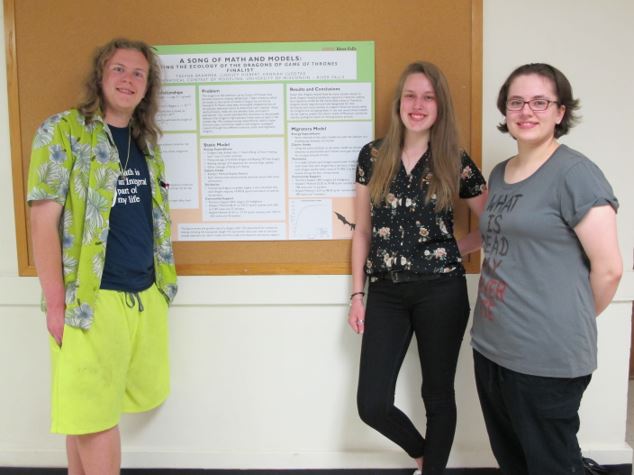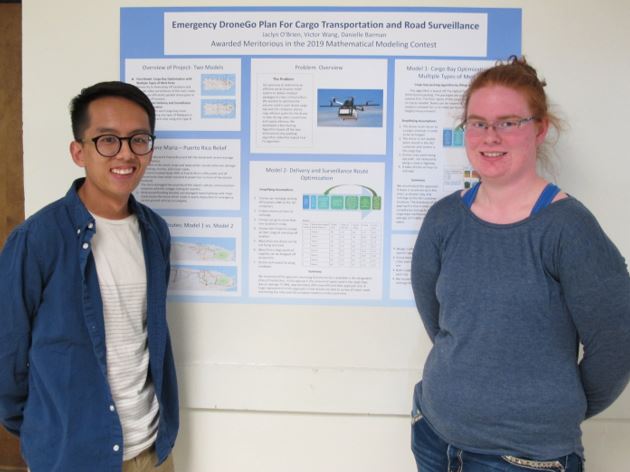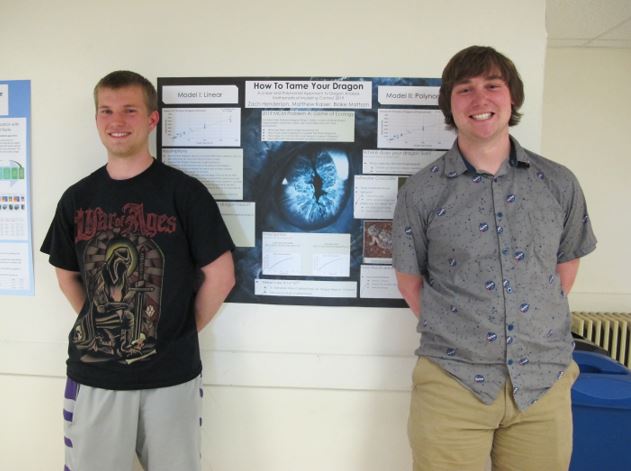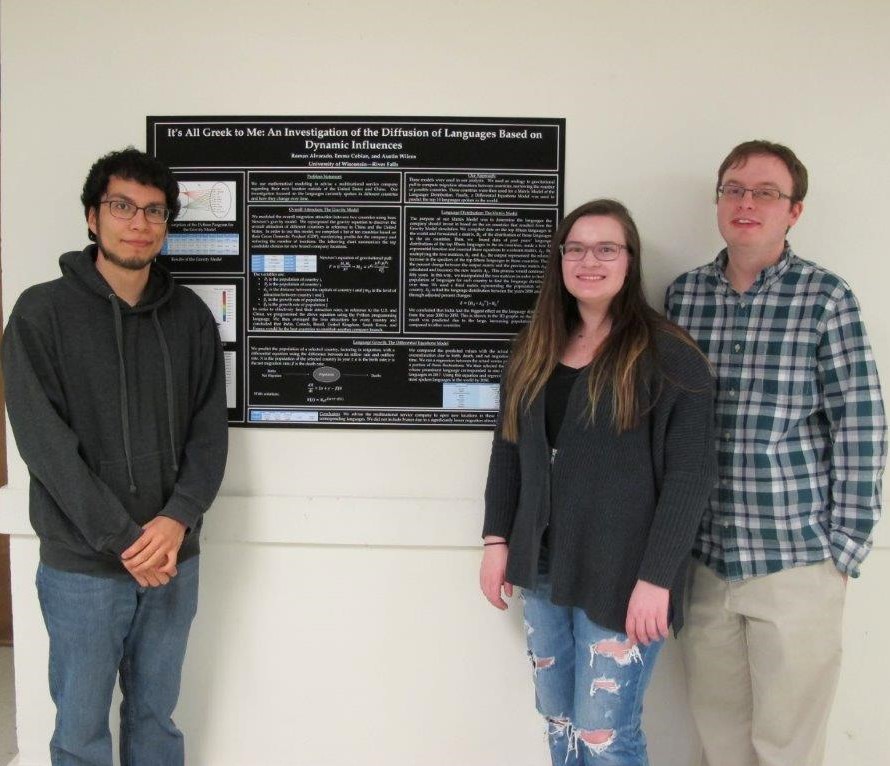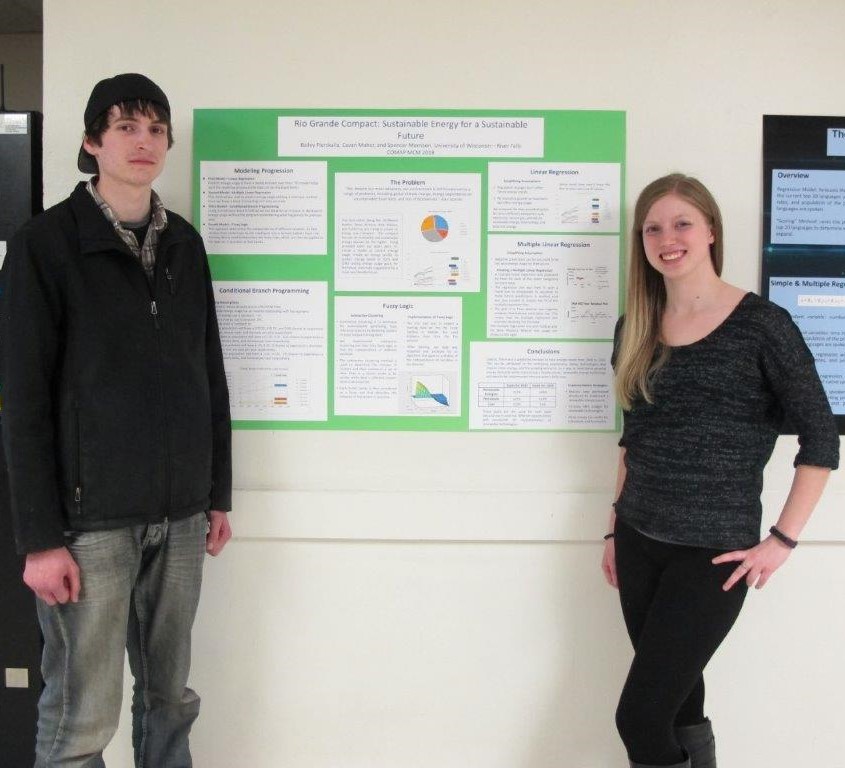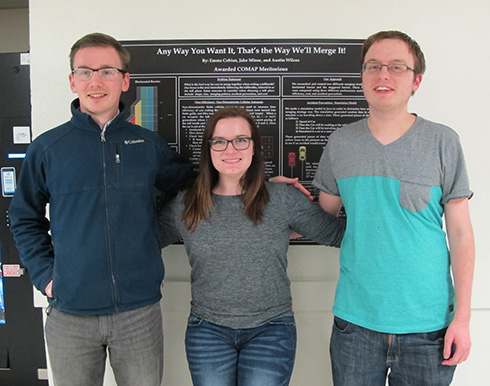UNIVERSITY OF WISCONSIN River Falls
Mathematics
Undergraduate Research
UWRF Math Modeling Team Finalist Winners of COMAP 2019 Contest
Team members Trevor Brammer, Lindsey Hiebert and Hannah Luedtke, pictured above share their research results as part of the events at the Third Annual Integration Bee. They wrote a paper addressing problem A, Game of Ecology. They wrote code in MatLab and R to implement several allometric equations that enabled them to determine food requirements for fictional dragons, with either migratory or non-migratory patterns, and thus recommend appropriate dragon ecology. They included a discussion of how their fictional dragon models could be applied to analyze dinosaur habitats and to inform scientists working to protect endangered species. Of the 14,108 international competitors, 25 teams were designated Finalists and 17 were Outstanding winners, placing Trevor, Lindsey and Hannah in the top 0.3% of all competitors.
UWRF Math Modeling Team Meritorious Winners of COMAP 2019 Contest
Team members Victor Wang and Danielle Barman, pictured above share their research results as part of the events at the Third Annual Integration Bee. Along with team member, Jaclyn O'Brien (not pictured) they wrote a paper to address problem B, Send in the Drones: Developing an Aerial Disaster Relief Response System. They used ideas from matrix theory, packing algorithms and Hamiltonian cycles to model storage and transportation of medical packages by drones throughout the island of Puerto Rico after a devastating hurricane. The Meritorious designation places them in the top 6.8% of the 14,108 teams that competed this year.
UWRF Math Modeling Team Successful Participants in COMAP 2019 Contest
Team members Zachary Henderson and Blake Mattson, pictured above share their research results as part of the events at the Third Annual Integration Bee. Along with team member, Matthew Kaiser (not pictured) they wrote a paper to address problem A, Game of Ecology. They modeled dragon weight as a function of age and then applied Kleiber’s Law, by comparing fictional dragons to real crocodilians, to determine dragon food requirements, which in turn enabled them to recommend an appropriate dragon habitat.
UWRF Math Modeling Team Honorable Mention Winners of COMAP 2018 Contest
Team members Roman Alvarado, Emma Cobian and Austin Wilcox, pictured above share their research results as part of the events at the Second Annual Integration Bee. They wrote a paper to address Problem B: How Many Languages? They used differential equations, matrix theory and an analogy to gravitational pull to analyze modern evolution of languages and thus advise a multinational company about where to open new offices. This designation puts them in the top 44% of the 10,670 teams that competed this year. The team also traveled to Madison to present their results at Research in the Rotunda.
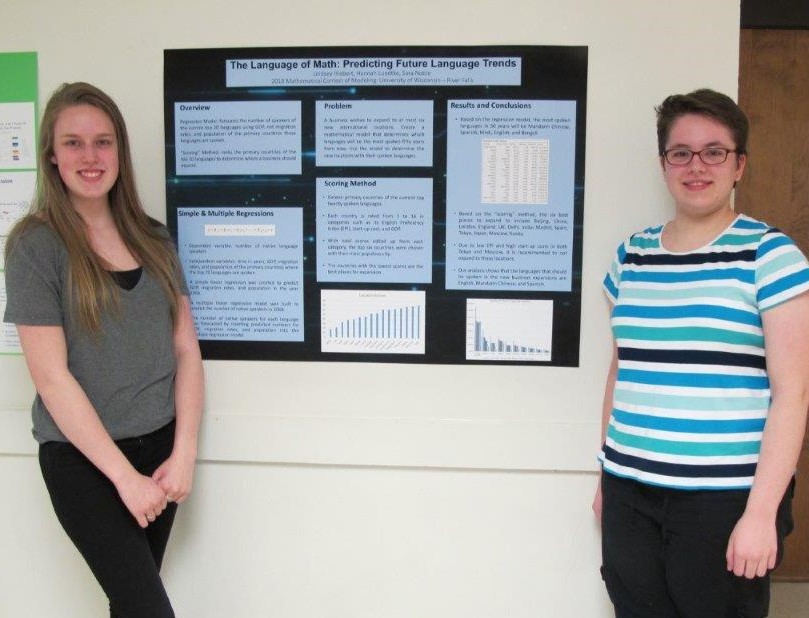
UWRF Math Modeling Team Honorable Mention Winners of COMAP 2018 Contest
Team members Lindsey Hiebert and Hannah Luedtke, pictured above, share their research results as a part of the events at the Second Annual Integration Bee. Along with team member, Sara Noble (not pictured) they wrote a paper to address Problem B: How Many Languages? They used ideas about correlation and regression in their linear model to analyze modern evolution of languages and thus advise a multinational company about where to open new offices. This designation puts them in the top 44% of the 10,670 teams that competed this year.
UWRF Math Modeling Team Successful Participants in COMAP 2018 Contest
Team members Spencer Morrison and Bailey Pierskalla, pictured above, share their research results as part of the events at the Second Annual Integration Bee. Along with team member, Cavan Maher (not pictured) they wrote a paper to address Problem C: Energy Production. They analyzed energy profiles of four southwestern states in order to inform state governments how best to cooperate in their energy production and usage. They wrote code in Mathematica to implement simple regression, multiple regression and conditional branch methods.
UWRF Math Modeling Team Meritorious Winners of COMAP 2017 Contest
Team members Jake Minor, Emma Cobian and Austin Wilcox, pictured above share their research results as part of the events at the First Annual Integration Bee. They wrote a paper to address Problem B: Merge After Toll, in which they compared a horizontal barrier and a staggered barrier for merging traffic after toll booths. This designation puts them in the top 8% of the 8843 teams that competed this year.
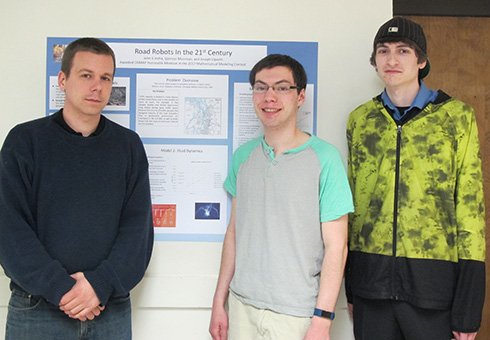
UWRF Math Modeling Team Honorable Mention Winners of COMAP 2017 Contest
Team members Joe Opseth, John Incha and Spencer Morrison, pictured above share their research results as part of the events at the the First Annual Integration Bee. In their paper "Road Following Robots in the 21st Century," they addressed Problem C: Cooperate and Navigate, about improving traffic congestion through the introduction of self-driving, cooperative automobiles. This designation puts them in the top 48% of the 8843 competing teams.
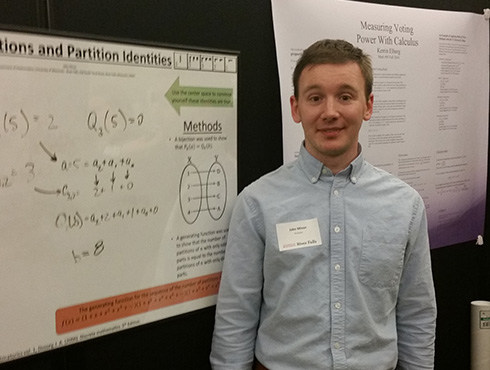
Generating Functions and Partition Identities
Jake Minor presented his research on "Generating Functions and Partition Identities" at the Fall Gala on Tuesday December 13, 2016
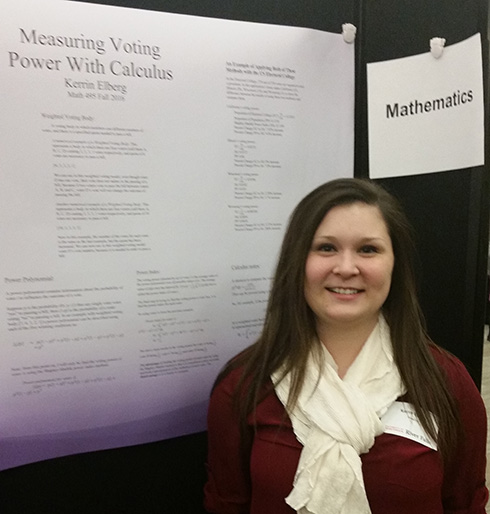
Measuring Voter Power with Calculus
Kerrin Elberg presented her research on "Measuring Voter Power with Calculus" at the Fall Gala on Tuesday, December 13, 2016.
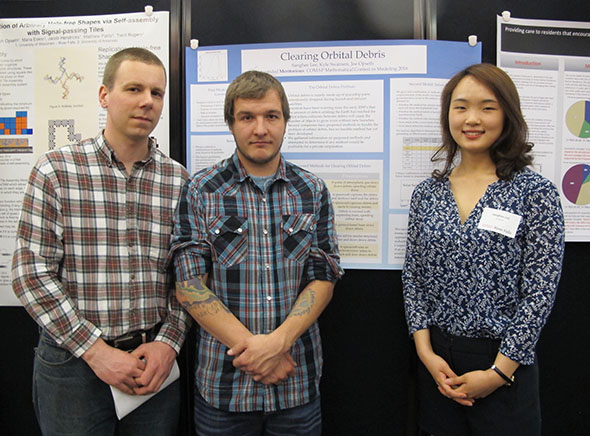
UWRF Math Modeling Team Meritorious Winners of COMAP 2016 Contest
Team members Joe Opseth, Kyle Swanson and Sanghee Lee pictured above share their research results on URSCA Day. The designation, Meritorious places them in the top 8% of all participants. In their paper, "Clearing Orbital Debris," they analyzed seven different methods for clearing space debris for commercial viability. Their model used ideas from combinatorics and Solow models.
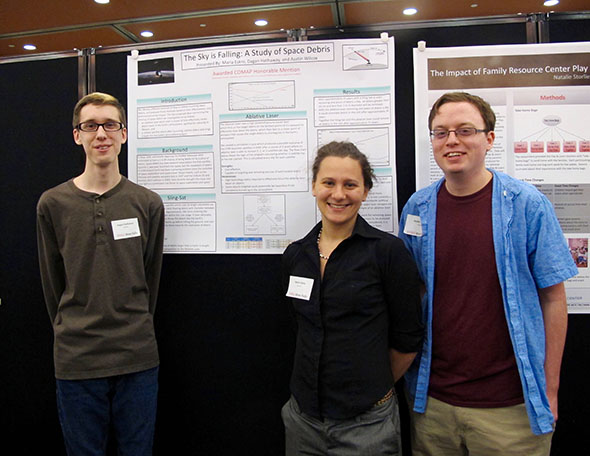
UWRF Math Modeling Team Honorable Mention Winners of COMAP 2016 Contest
Team members Dagan Hathaway, Maria Eskro and Austin Wilcox pictured above share their research results on URSCA Day. The designation, Honorable Mention places them in the top 43% of all participants. In their paper, "The Sky is Falling: A Study of Space Debris," they developed a computer simulation to analyze the financial and political viability of clearing space debris with either a sling-sat or an ablative laser.
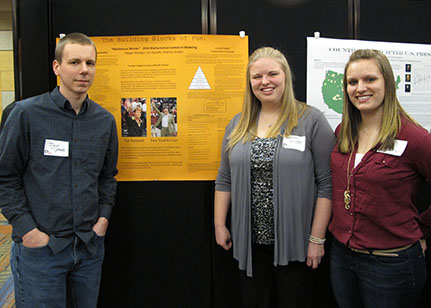
UWRF Math Modeling Team Meritorious Winners of COMAP 2014 Contest
Team Members Joe Opseth, Heather Snyder, and Abby Mediger pictured above share their research results on Research, Scholarly & Creative Activity Day on campus. On February 6-10, the team participated in the 2014 Mathematical Contest in Modeling administered by COMAP (Consortium of Mathematics and Its Applications). They earned the designation: Meritorious Winner, placing them in the top 10% of all participants. The internet-based competition involved 6755 teams from eighteen countries. The UWRF team developed a mathematical model to solve the Problem B challenge, "College Coaching Legends," which asked competitors to develop metrics that would determine the best coach in a variety of college sports.
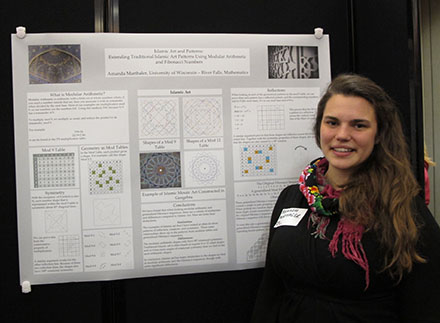
Islamic Art and Patterns: Extending Traditional Islamic Art Patterns Using Modular Arithmetic and Fibonacci Sequences
Amanda Marthaler presented her project on Islamic art at the Research, Scholarly, & Creative Activity Day on April 17, 2014. Her project observes and analyzes the patterns within modular arithmetic and modular generalized Fibonacci sequences, and how they relate to shapes found in Islamic art.
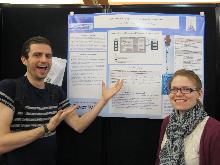
UWRF Math Modeling Team of COMAP 2013 Contest
Team members Charles Collins and Amanda Finke share their research on the Water, Water Everywhere problem with their paper, “Efficiently Satisfying the Water Needs of the United States.” They worked together with teammate Laura Rogers to analyze routing, supply, demand and cost of water distribution by creating a model based on the operations of the United States Postal Service.
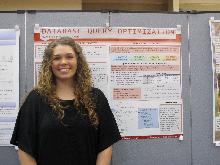
Database Query Optimization: An Analysis of Relational Algebra
Lisa Rosenthal presented her project on optimizing executional time of relational queries at the Research Scholarly & Creative Activity Day on April 18, 2013. Using SQL (Structured Query Language) with an Oracle database, Lisa evaluated different algorithms and strategies using parse trees to find more efficient ways of manipulating algebraic expressions associated with a variety of queries.
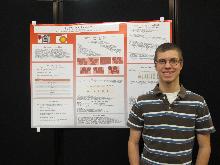
UWRF Math Modeling Team of COMAP 2013 Contest
Tyler Hefty shares research on the Ultimate Brownie Pan problem that he completed with team members Jacquelyn Trepanier and Laura Kleppe. In their paper “Architect of the Future Brownie Pan,” the team analyzed heat flow in polygonal brownie pans and the packing problem for polygons in a rectangular oven. They concluded that with circular pans they could balance the goals of maximizing the number of brownies cooked at one time while preserving even heating.







